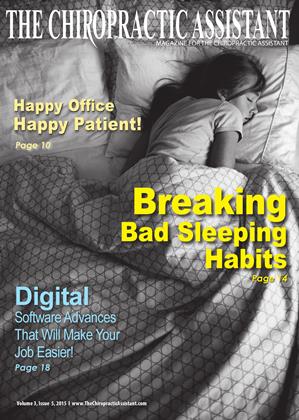Creating an Aesthetic Chiropractic Office
JC Smith
An article in The Wall Street Journal titled “Best and Worst Jobs of 2013" reviewed 200 jobs in America and surprised many when chiropractors were ranked 11, considering “general physician" ranked 45 and “surgeon" ranked 51. The ranking of chiropractic has improved steadily from 56 in 2010 to 32 in 2011, and then to 19 in 2012.' (Incidentally, at the bottom of this list were roustabouts.)
The data for this list comes from a survey by Career Cast that ranked 200 jobs from best to worst based on five criteria: physical demands, work environment, income, stress, and hiring outlook.'' In other words, the culture of the job was more important than only making money.
Let me make a few suggestions for how your office can create such an environment that makes you love to go to work.
My experience in chiropractic includes 35 years in practice while writing articles, books, and educational materials. I've also attended many seminars
ii/'ve concluded that whatever the clinical technique, location, or advertising that might be used, the number one asset for any office is a professional staff, which may also be the hardest
element to master.99
on leadership and practice management to learn how to be a success. I've concluded that whatever the clinical technique, location, or advertising that might be used, the number one asset for any office is a professional staff, which may also be the hardest element to master.
I've spent many hours reading leadership and management books outside of the profession, so let me share with you a few tips to help your office run
smoothly while offering a great service to an ailing public. Even if you've attended practice management classes or a chiropractic assistant program, please keep an open mind with me.
Imagine starting a football team from scratch where both coaches and players are new to the game—all eager, but untrained and undisciplined. I've developed dozens of CAs during my career and very few came to me from another office as welltrained assistants.
Too many new CAs had never been disciplined by a coach, in the military, or in another organization, so often they had an amateur attitude that was resistant to change or advice. So my first tip is to be coachable—don't take criticism personally, but take it professionally.
I teach my staff that there are different aspects of their position:
1. Transactional management:
This is where they master the elements of their job from A to Z—all of the steps necessary to complete the patient's case from the first day they enter the office to the progress report where
they are dismissed, placed on maintenance care, or referred for whatever future treatment they may have elsewhere. Learning the various steps is crucial for mastering each position, just as a baseball player must learn the steps of playing his or her position to work in harmony with other players.
2. Transformational management:
This is undoubtedly more important and harder to master for the CA and the doctor. Here the goal is to reposition new patients to become compliant patients, but this transformation is a psychological challenge that few people can master alone without a bigger picture. When new patients come to our office, I warn my staff that most of these people are in pain, so what we initially see is not a true picture ofthat person. Some are skeptical of chiropractors due to medical propaganda over the years, many are cost conscious, and most are health negligent and chiropracticaIly naïve. They may be short tempered, rude, and anxious—they simply are not themselves. However, with proper people skills, understanding, and good clinical results, these skeptics often become your most grateful patients. So, be patient with these patients.
3. Transcendental management:
This is the most fun in the office to educate patients about the higher aspects of chiropractic and wellness. Most people are medically tainted and health negligent, so they are clueless about real health care; all they have experienced is sickness care. Repositioning people to our scheme of natural health care is enlightening, and it will change their lives when they learn about neurophysiology, nutrition, supplements, aerobic, and spine exercises. Indeed, for people locked into the medical model of the germ theory and "pill for every ill" paradigm, to learn about vitalism and neurophysiology is a milestone that few people ever attain.
As you can see, working in a chiropractic office is a unique experience unlike any medical or dental office. Once you master these three types of management, I urge you to continue to grow on your own path of enlightenment as a worker and as a person on the path to health yourself. Education is the key to this growth.
Staff meetings should not focus only on new patients, patient volume, total services, collections, and the business side of our practice. These meetings should be an open discussion about innovative management concepts, motivating thoughts for growth, and how to gel as a team to perform better. We often listen to great motivators, such as Zig Ziglar, Stephen Covey, Robert Schuller, just to name few. We discuss their concepts to enlighten ourselves to create an enjoyable and enriching environment in which to work.
Chiropractic is a dynamic profession in many ways and if you and your office embrace these concepts, you can create an exciting and rewarding place to work. Then you will understand why chiropractic is the eleventh best job in America.
References:
i. Joe Light, "The Best and Worst Jobs," The Wall Street Journal, (January 4, 2011)
ii. Andrew Strieber, "Jobs Rated 2011: Ranking 200 Jobs From Best to Worst," (January 5, 2011) CareerCast. com
HJC Smith, MA, DC, is a 35-year practicing chiropractor, author of The Medical War Against Chiropractors, and he maintains a popular website, Chiropractors for Fair Journalism.
 View Full Issue
View Full Issue






